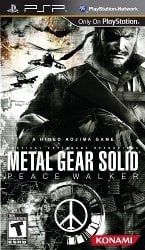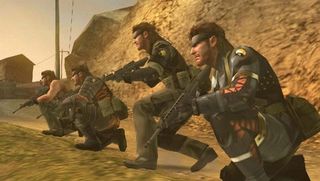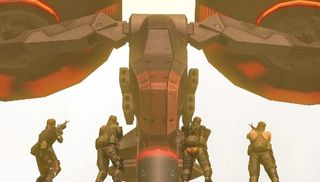
Action games often pose problems for handheld developers. The standards for visuals and controls are a bit more stringent than they are for other genres and those are the two areas in which handhelds are inferior to consoles. Still, Kojima Production manages to dig deep with Metal Gear Solid: Peace Walker and get more out of the PSP than perhaps any other studio.
Peace Walker takes place in 1974, ten years after Metal Gear Solid 3: Snake Eater and four years after Metal Gear Solid: Portable Ops. Naked Snake (aka Big Boss) is now in control of a mercenary army operating in Central America. They receive a contract to help the pacifist nation of Costa Rica rid itself of a mysterious military force known as the Peace Sentinels. Snake soon learns that Sentinels are attempting to build a new breed of Metal Gear, one without a human pilot.
This game and Portable are supposed to bridge the considerable gap in time between Snake Eater and the original NES game Metal Gear. It’s an important piece of the overall storyline that shows how Big Boss goes from hero to villain. However, Peace Walker feels like a side story. We’re introduced to a host of characters we’ll never see again and events that will never be referenced again. There’s about a twenty year gap between Peace Walker and Metal Gear (the latter takes place around 1995) so don’t expect this game to tie everything up in a neat bow. On the bright side, you can play the game without knowing much about the rest of the series’ storyline. What little you'd need to know about Snake Eater's plot is recapped ad nauseum.
The difference in graphics between Peace Walker and predecessor Metal Gear Solid: Portable Ops is shocking. Portable looked like the original PSOne Metal Gear Solid with dull, blocky environments. Peace Walker more closely resembles Metal Gear Solid 3 on the PS2, with wide open outdoor locations. It's hard to believe Portable and Peace were both developed for the same system.
Granted, some compromises need to be made to deliver those production values on a handheld. There's a lot of backtracking in the campaign and the optional side missions re-use a small collection of stock maps. The cutscenes are mainly motion comics rather than in-engine footage. To keep load times manageable, the player can opt to install part of the game's files to their memory card. There's two types of installs offered, one about 300 MB and the other around 800. I played with 800 and the load times were okay; I assume it's a bit sluggish without any sort of installation. In spite of these adjustments, the fact remains that the game's one of the best looking titles on the system.
The controls take a cue from Metal Gear Solid 4 and feel like a contemporary action game. Snake's movement is controlled with the analog stick and weapons are fired and aimed with the shoulder buttons. Aiming is performed in an over-the-shoulder view, which is less jarring than a switch to first-person mode. However, the lack of a second analog stick means that you'll have to slowly arrange your crosshair by pressing the direction pad or face buttons (depending on the control scheme you pick). The game provides an auto-aim mode that can be toggled on and off but I found it to be pretty worthless. It didn't lock onto targets very reliably and in some cases would force me to fire in a direction where there were no enemies or at an object an enemy was hiding behind. I stuck with the manual aiming, sluggish as it was.

In another welcomed break from Portable Ops, Snake can move while crouched. Crouching is toggled with a button press (the down arrow, in the default setting). You can also hold that same button down to go prone, though you're unable to move while hugging the ground. The immobility is part of the reason why I never went prone. The better rationale, though, is that I never needed to. The game's stealth is dumbed down compared to console iterations. You can still deck yourself out in camouflage and your visibility to guards is expressed with a percentage at the top but the stealth really just comes down to staying out of enemies' line of sight and approaching them slowly from behind for takedowns. Camouflage can't be changed mid-mission so finding the right suit for a situation is tough. Besides, you've got more pressing concerns when choosing your outfit than color scheme; certain outfits have more capacity for ammo/items than others or additional protection. Still, going the extra mile and trying to be as stealthy and non-lethal as possible has its benefits; at the end of the mission, you’re given Heroism points based on your performance and these help you unlock additional items quicker.
CINEMABLEND NEWSLETTER
Your Daily Blend of Entertainment News
Though the upgrades in controls and graphics are nice, my favorite new feature in Peace Walker was a simple one: the Fulton Skyhook. In Portable Ops, Snake recruited new soldiers for his army by knocking them out and then dragging their fat asses across the entire map. In this game, though, all you need to do is equip your Fulton and press a button while next to a downed enemy. Snake will attach a sort of tiny parachute to their body while pulls them into the air so they can be picked up by a friendly helicopter and brought back to base (think of the Hong Kong scene in Dark Knight). While the Fulton contributes to the simplicity of the game's stealth (you no longer have to worry about hiding bodies), it's a very user-friendly solution that prevents mindless backtracking.
A bigger difference in the missions is that you play one character. Players switched between multiple characters in Portable Ops missions but if you want back-up in this game, you'll have to rely on other players. The game supports 2-4 player co-op – two players for normal missions, four for boss fights). Having another gun in the fight is always useful but there are other little perks. You can share items, resuscitate your friend when he goes down, or help him get to previously inaccessible ledges. It's a fun new direction for the series but it does make things tougher if you're playing these missions solo. The nice thing about having spare characters on hand in Portable was that if you died, you could send in the next character without missing a beat. You don't have that insurance in Portable and there's very few checkpoints so you'll be reloading and replaying a lot of missions.
The game’s really designed to be played with friends and this becomes clear during the boss fights. All of the bosses in the game are automated Metal Gears. Each of these giant robots has a red and black cylinder that houses their artificial intelligence and to take them down, you need to hit this A.I. pod repeatedly. This is no easy task considering how quick these mechs are and how slow Snake is. The sluggish aiming isn’t such a bad thing when you’re trying to shoot an oblivious guard with a tranquilizer gun. However, it’s a liability when you’re trying to fire an RPG at a specific point on a Metal Gear as it speeds past you.
Even a direct hit on the A.I. pod only takes off a sliver of the boss’ health so you’ll have to call in several supply drops to stock up on ammo. You’ll also want the rations that these supply drops contain as the Metal Gears tend to spray you with machine guns and heat-seeking missiles, both of which hurt you a lot more than you hurt this boss. If you’re doing these fights by yourself, they might take 15 minutes or more. The game doesn’t seem to recalibrate its difficulty based on how many players are participating so these encounters with Metal Gears are torturous when played solo. It’s too bad because they sure looked fun in the trailers.
If and when the game kicks your ass, though, there’s a way to bulk up. The game has an RPG-like progression that centers on Mother Base, the headquarters for Snake’s mercenary army. As you recruit characters (mainly with the Fulton recovery device mentioned earlier), you slot them into different assignments: Combat, Research, Mess Hall, Medical, or Recon. Combat troops earn you the resources you need to conduct research on new items and weaponry. The Mess Hall provides food to your base’s population (which can grow up to 350 strong) and if there’s a surplus, your personnel will get temporary skill bonuses. The larger your Medical team is, the faster your wounded troops will recover. Recon, meanwhile, determines how many supply drops and airstrikes you’ll be able to call in. Developing the Recon, Mess Halls, and Medical teams also unlocks related items for research (for example, a strong Mess Hall team will enable you to research better foods). While Research is what really makes Snake more effective in the field by upgrading and unlocking new items/weapons, you need to make sure you don’t neglect your bases’ other teams.

Suppose, then, that you were stuck on a boss fight. Perhaps you’re about to do the aerial mech fight and you haven’t researched the surface-to-air missile launcher yet. To ensure you have enough cash to research the launcher, you send your Combat troops on simulated Outer Ops missions. If they survive these missions, their skills will increase and the amount of GMP (the game’s currency) that they’re worth will increase. Your troops can die or get injured on these Ops, though, so you have to be sure to send them on assignments that are appropriate for their skill level. The more difficult the missions, the better the items they’ll unlock so there’s some incentive to send them on riskier ops.
You can actually watch these Outer Ops play out, if you wish. They look like old JRPG battles, with two lines of 2D sprites taking turns attacking each other. I’m not sure why the developers thought you’d like to watch this. If anything, it made me wish I could manually control my troops. When controlled by A.I., they’re pretty stupid. They don’t focus fire and their choice of weapon seems random (e.g. shooting a soldier with an RPG and then a tank with an assault rifle). I suspect manual control was in the works at one point and ended up on the cutting room floor. Shame, because it might’ve made for a decent minigame.
Anyway, now that you’ve got enough GMP, you’ll start to research the launcher. Outer Ops and research projects will only be completed while you’re on a mission, though, so to pass the time you can do Extra Ops. These optional, repeatable missions allow you to recruit personnel and acquire equipment. There’s over a hundred of them so they’ll also be able to provide you additional entertainment once the 15 hour campaign is over. The fact that the game recycles campaign missions for these side quests is unfortunate, though. Considering they’re also used for the six-player deathmatches in Versus Ops, too, these locations can get old very quickly.
With Peace Walker, Kojima Productions manages to adequately replicate the MGS console experience on a handheld. Developers often beat their chests and talk about how their game makes use of 100% of a platform’s potential but in the case of this game, it’s a pretty accurate claim. They’ve managed to cram a lot into the PSP but they’re reaching a ceiling, here. If the developers want to make the next portable MGS to make as big of a leap as Peace Walker did, it looks like they may need a new handheld - preferably one with a second analog stick.
Players: 1-6 (competitive multiplayer), 1-4 (co-op)
Platform(s): PSP
Developer: Kojima Productions
Publisher: Konami
ESRB: Teen
Rating:

Staff Writer at CinemaBlend.
Most Popular





